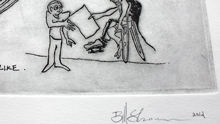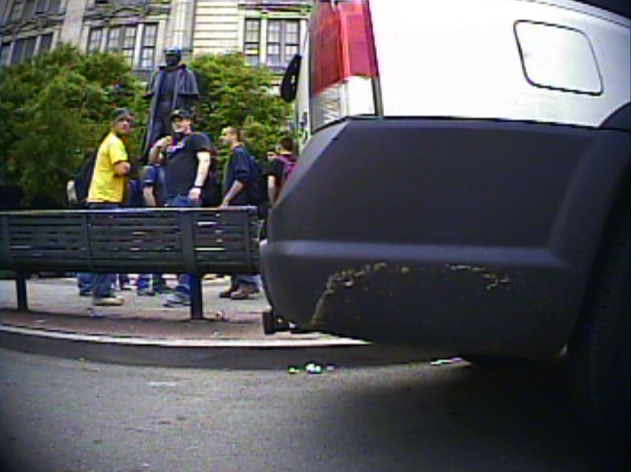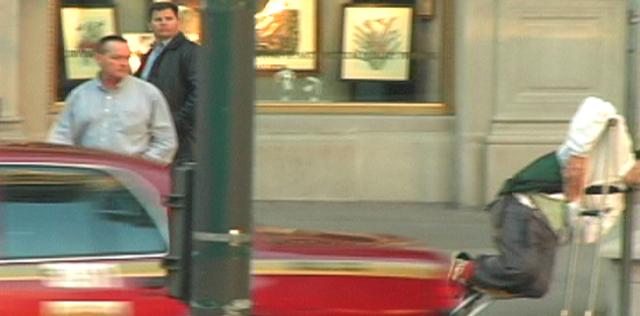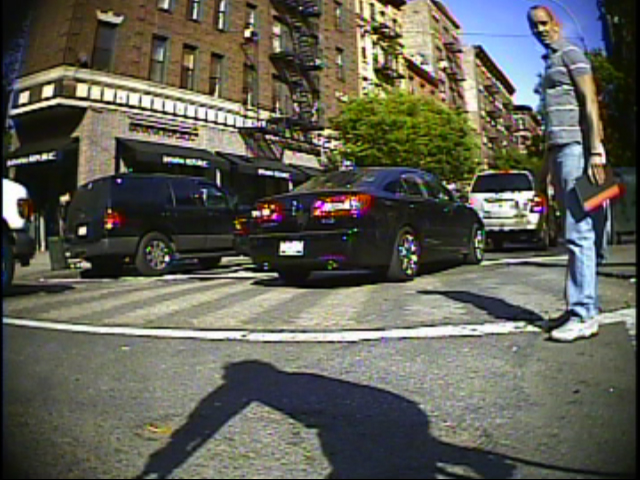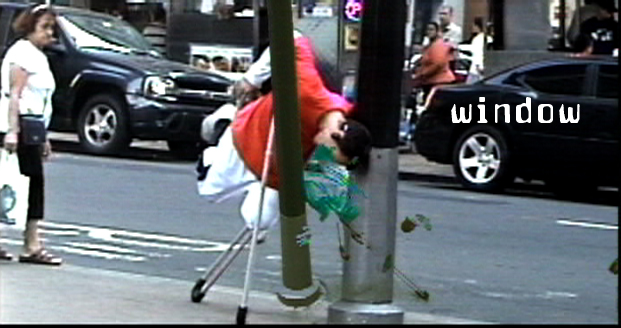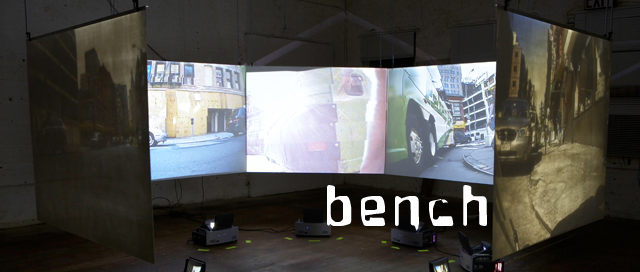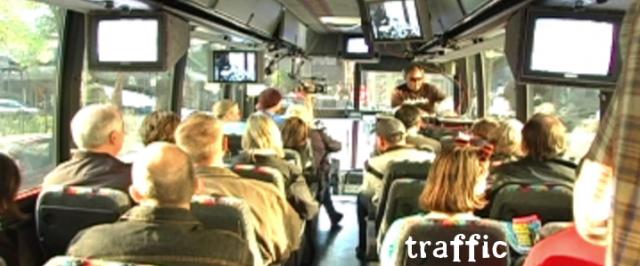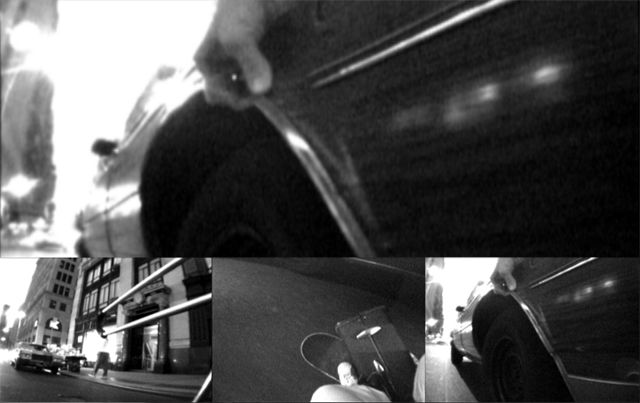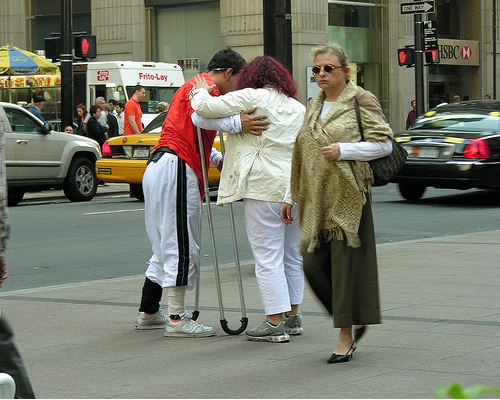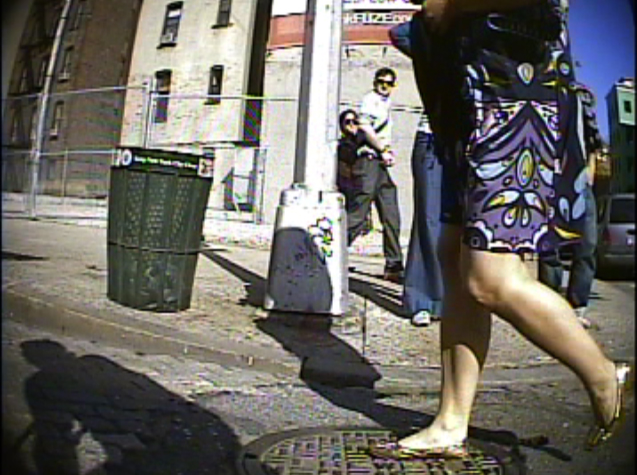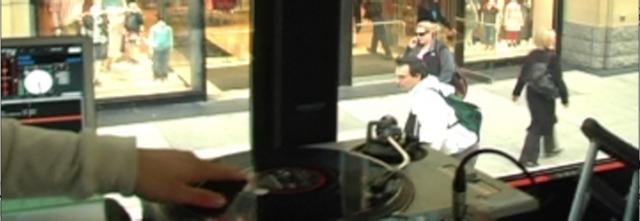TShirts, Stickers, Prints, Art Objects
WhatIsWhat 1.0 2003
Shannon Public Works Trilogy
“Through Shannon Public Works*, I plan on reconciling the gap between what I feel is possible in experiencing street performances and what audiences up until this moment have been able to experience. The three interrelated projects making up Shannon Public Works are connected by the conceptual belief that a naturally-occurring street environment is imposed upon by an audience to the extent that a virtual proscenium is manifested and the performance is thereby isolated from the very environment it is meant to exist within. The efforts made in Shannon Public Works address this conceptual belief and are designed to allow an audience to watch a performance in the street while preserving the integrity of the landscape. In short, I wish for audiences to see as I see and walk as I walk but at the same time allow me space to share without being in the context of their gaze.”
Shannon Public Works is a three-part multimedia performance and video project. This project features Bill Shannon's unique hybrid movement form and performance style and is designed to provide audiences with a dynamic connection to the live performances as they are performed in the urban setting and to mitigate the challenges inherent in navigating performances in public space. Each of the three projects in the trilogy address the complexities of retaining the authenticity of a naturally-occurring street environment while also inviting an audience to observe a performance taking place in the street. The overarching design of the series is concerned with the placement of the audience. Window, Bench and Traffic allow audiences to observe the street performances without their salient presence in the “performance space.” An audience’s manifest presence invariably alters random pedestrians' naturally-occurring relationships to the street environment and Shannon’s ongoing performance. The artist’s goal is to put the audience closer – both physically and experientially – to the artist’s unique practice of transient street performances. Having the “audience as voyeur” preserves the authenticity of the street environment by not disrupting its flow with their deliberate presence. This goal of the series is only important when understood in the context of Shannon's reliance on a street landscape that is undisturbed by an audience focused on him as a performer. In this light, it is understood that to be in the street as a deliberate audience is to change the nature of Shannon's relationship to the random pedestrian and the street to such a degree that the purpose of Shannon’s performance is compromised. That purpose is ultimately to show audiences Shannon's street as it naturally exists for him. In this manner, Shannon mixes his real life relationship to the street with the delivery of a performance with varied nuances of dance, sociology, acting and other elements. The three projects reflect different ways to achieve this goal.
Window is a public street performance work created for a ticket holding audience to observe through a window from inside an adjacent building. The invited audience observes the pedestrians naturally interact, ignore, bypass and or observe the events of the performance without a salient presence. It is in this birds eye approach that Window is used as a forum for Shannon to share the phenomenological framing devices that he applies to his various encounters with the public. In this video clip Shannon situates ambiguity of disability and the process of retaining sculptural integrity as a dance performance of transitions between crisp lines that is misinterpreted as failure. The continuous live two way audio and video feed mixed down by the VJ and Dj feed the theater audiences the information and offset the significant physical distancess between the parties.
Bench is a traveling street performance designed for a random audience during its performative image-capturing phase that is subsequently transformed into a video and sound installation to be viewed by a gallery/museum audience. In Bench, the pedestrian becomes the “unconscious performer” as their reactions to Shannon’s movement in the street is captured and later on witnessed by the gallery audience.
Traffic is a traveling street performance of choreographed and improvised movement for an audience inside a moving tour bus and the random audience of pedestrians in the street. Because the street performance moves through a significant distance, Shannon performs for both a random audience in the immediate vicinity at a point in time and for a deliberate audience who follows and sees the entirety of the lyrical journey.
Shannon’s street performances incorporate musical skateboarding, freestyle street dancing, Shannon Technique, Disability-based Utilitarianism, silent film-era acting, improvisational sociological experimentation, choreographed kinetic site-specific architectural interaction, live real-time audiovisual communication and video projections -- opening a window into a world of new kinetics and sociologically challenging movement art in public space. These diverse elements taking place in the work are all based on Shannon’s past performances in various contexts. There is no specific chronology in terms of presenting the parts, although they progressively take the audience into more experimental forms of experiencing the transient- and site-specific nature of Shannon’s street performance.
WINDOW The audience for Window is overlooking an urban intersection from above and the performance in its entiretyis seen through windows facing a street intersection. Shannon performs over a city block or more as visible through the window. The performance is both improvisational and choreographed. The choreography for Window is built to accommodate chance encounters with random pedestrians. Each encounter is a departure from the arranged presentation and is explored as such. With each conclusion of a chance encounter, the show continues as originally choreographed. The technical elements of Window are in service to building a connection between the street performance space and the theater-like audience space. The ultimate goal of Window is to provide audiences with the familiar experience of sitting and watching a performance while also displaying a negotiation of random events IN A PHENOMENOLOGICAL FRAMEWORK.
BENCH In Bench, the pedestrian becomes the “unconscious performer.” In a gallery setting, the audience will watch video of pedestrians’ candid reactions (or non-reaction) to Shannon’s presence. The perceptive disconnect of an ambiguously, though definitively, physically disabled person dancing on a skateboard with crutches in the street is an interesting sociological exploration – one that elicits spontaneous response from pedestrians in the artist’s path. The video is shot primarily in the first person, hence the audience sees pedestrians from Shannon’s point of view. The conceptual basis of Bench is similar to what sociologist Erving Goffman discusses in “The Presentation of Self in Everyday Life.” In this work, Goffman defines interaction as “performance,” shaped by the environment and audience. The performance exists regardless of the intent of the individual, as persona is often imputed to the individual inspite of the individual’s lack of intent to perform. The persona is defined by the “front” – a vehicle for standardization that allows others to understand the individual on the basis of normative character traits. Because the artist, in effect, breaks this collective representation in his everyday life, he elicits sociological phenomena that is a break from the norm. The installation is presented as an artifact of a live street performance process. While sitting on a park bench within a six-screen, in-the-round video installation, the audience experiences Shannon's traveling dance and skateboard choreography from the inside-out. The performance leading up to the video installation involves Shannon's control of six micro-cameras pointed outward in a 360-degree arrangement embedded in a suitcase carried on his skateboard. Cameras record the streetscape and his encounters with pedestrians. The video and sound from that performative video recording is then edited down to "events" that have significant sociological and/or aesthetic value. The "events" are seamlessly edited together through video editing and compositing techniques to create a shorter length video installation loop. The installation phase places the audience literally on the body of the performance as it moves through space via images captured by the micro-cameras -- providing multiple perspectives of the performance and giving the audience a sensation of being “in situ” with the artist. What is unique is the ability of the audience to absorb the performance from different viewpoints, sometimes moving with the artist’s body simultaneously, seeing space in the first person and in the third person when Shannon alights from the skateboard. The sound design of the installation footage enriches the in-the-round viewing experience of the events for the gallery audience. In a secondary room, the full-length, unedited video footage will be available for audiences to see the choices made by the artist in a process. These will be on small reference displays arranged in-the-round with minimal audio corrections. Also displayed in this second room are the unique rigging equipment used, the crutches, skateboard and other physical artifacts from the performance. The ultimate goal of Bench is to bring audiences inside the artist’s point of view during his interactions with strangers in the public arena. This is impossible if recorded by an outside camera person whose presence will discourage natural reactions and will be from a point of view of a person looking in.
TRAFFIC Weightless Rhythmic Skating is a dance form that can only be fully observed if the audience travels with it. Through Traffic, Shannon takes the audience with him in this voyage of dance. Weightless Rhythmic Skating combines the stylistic funk and flow of 1970's rollerdisco with footwork patterns performed in a rhythmic fashion on the surface of the skateboard to music. The overall appearance of the skating is closer to a cross-country skier than a skateboarder due to Shannon's use of modified "rocker-bottom" crutches to de-weight out of his hips and into his arms. The unique combination of the use of the crutches with the skateboard enables Shannon to seemingly float on top of the board and dance out steps impossible in the traditional use of a skateboard. The audience for Traffic rides on a chartered tour bus observing the performance through one-way windows that pedestrians can’t see through. The bus travels through city streets on a predetermined path. Shannon performs both transient-specific choreography around the traveling bus and site-specific choreography at prearranged stops. The relationship of the audience to the work from a moving tour bus will be created as Shannon paces the bus and the bus in turn paces him. The traveling relationship is fully realized as the bus intermittently pulls over for an arranged observation of a site-specific performance sequence before traveling onward with Shannon to yet another location. The transient choreography of Traffic features Shannon’s invented form of rhythmic skateboarding. The site-specific choreography features the artist’s invented form of Shannon Technique for dance on crutches. Themes of the choreography for Traffic include radical relationships to urban architecture and the skater ethos. A multimedia real-time connection between the artist and the audience on the bus will be maintained throughout the entirety of the performance event. Cameras mounted on the bus feature live feeds to monitors in the bus, allowing the audience to see Shannon at all times, no matter which side of the bus he is performing on. Music from Shannon’s headphones will be sent wirelessly to the bus allowing the audience to witness his notion of expressing rhythm and melody, on a skateboard, over the span of blocks. The ultimate goal of Traffic is to share with live audiences the vibrancy of musical skateboarding over a landscape as it happens and allow the audience to experience the intensity of the dances’ relationship to street elements as interpreted through the skater ethos.
